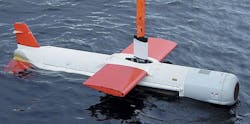Navy to buy three AN/AQS-20A mine-hunting sonars from Raytheon in potential $199.7 million deal
WASHINGTON, 21 Feb. 2014. U.S. Navy counter-mine experts needed mine-detecting sonar systems for the mine countermeasures mission package of for the littoral combat ship. They found their solution from the Raytheon Co. Integrated Defense Systems segment in Portsmouth, R.I.
Officials of the Naval Sea Systems Command in Washington awarded a $35.5 million contract to Raytheon Wednesday for three AN/AQS-20A sonar mine detecting sets and related equipment. The contract has options that could increase it to $199.7, Navy officials say.
The AN/AQS-20A is a mine hunting and identification system with acoustic and identification sensors housed in an underwater towed body. The acoustic sensors detect, classify, and pinpoint bottom, close-tethered, and volume enemy mines in one pass.
Related: New ship takes lead in countermine and anti-submarine warfare
The AN/AQS-20A is an integrated acoustic and electro-optic sensor system with a hydrodynamically stable towed body sensor that can be operated from on Navy MH-53E and MH-60S helicopters, as well as from the and AN/WLD-1 remotely operated underwater vehicle. The system can find and neutralize sea mines placed as deeply as 450 feet.
The system's sidescan, forward-looking, and gap-filler sonars detect and pinpoint sea mines from long ranges. Its Streak Tube Imaging Lidar (STIL) electro-optical sensor provides high resolution 3D images at short ranges to help identify bottom and moored mines.
The STIL sensor, also called Electro-Optic Identification (EOID), is from Raytheon partner Areté Associates Optical Engineering in Tucson, Ariz. The STIL sensor fits in a space of the towed body that is 15 inches in diameter and 19 inches long.
Related: Ocean mines have nowhere to hide
The AQS-20 uses imaging sonars, signal processing, and computer algorithms to localize mine-like objects and alert the system operator with a visual image and a contact data list. The system is 10.5 feet long, 15.5 inches in diameter, and weighs 975 pounds.
AQS-20 sends sonar and imaging data up its fiber-optic tow cable to the operator console located either aboard the host helicopter or by wireless data links to operators aboard nearby surface vessels. The operator’s station has a high-speed data recorder to store mission information for later analysis.
Related: Lockheed Martin to upgrade RMS minehunting underwater vehicle capability and reliability
On this contract Raytheon will do the work in Portsmouth, R.I.; Tucson, Ariz.; Pawcatuck, Conn.; Middletown, R.I.; Glen Rock, N.J.; Windber, Pa.; Cincinnati; Big Lake, Minn.; Woodland Hills, Calif.; Lewisburg, Tenn.; Huntsville, Ala.; Poway, Calif.; North Springfield, Vt.; and Hampton, Va., and should be finished by February 2015.
For more information contact Raytheon Integrated Defense Systems online at www.raytheon.com, or Naval Sea Systems Command at www.navsea.navy.mil.

